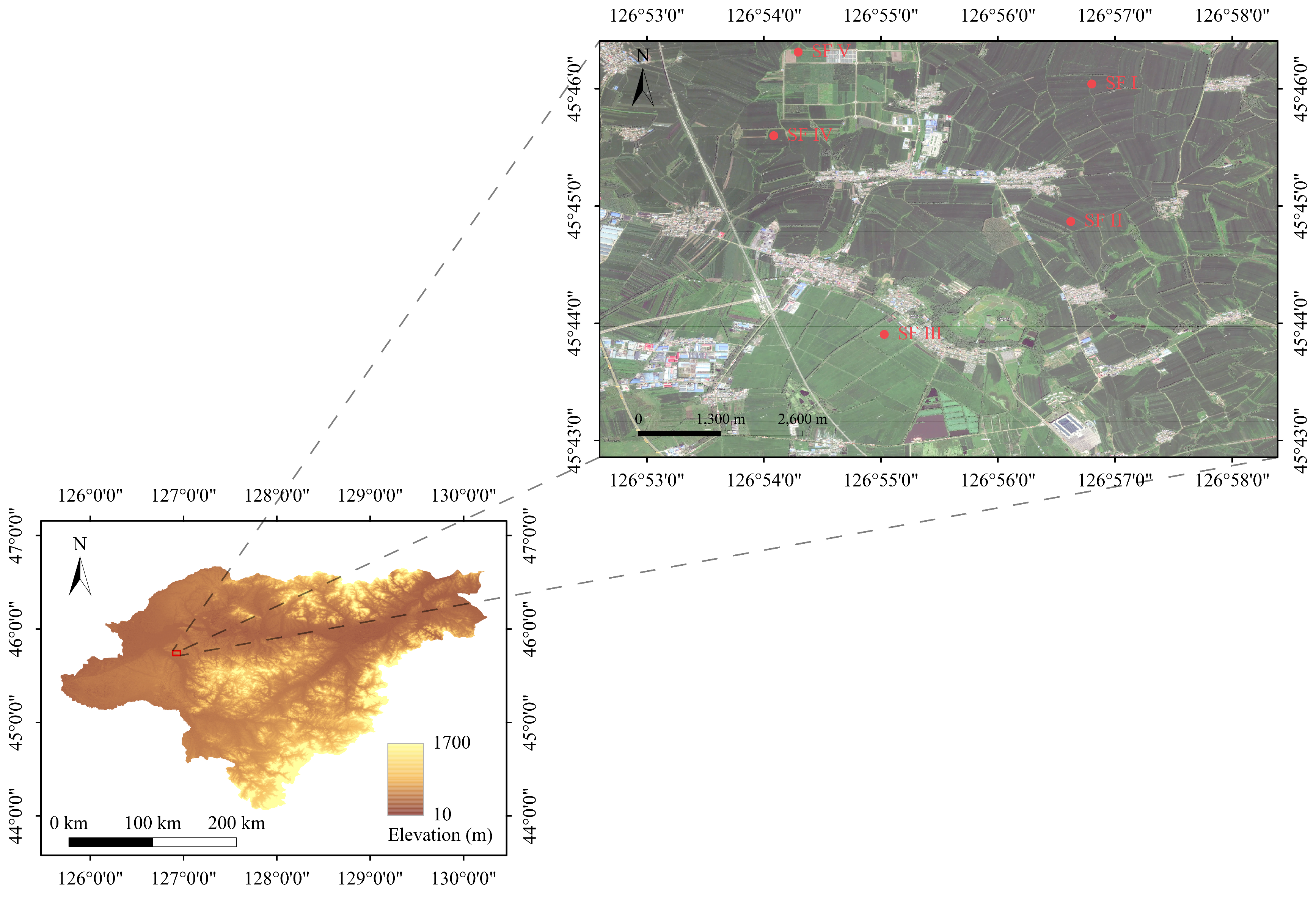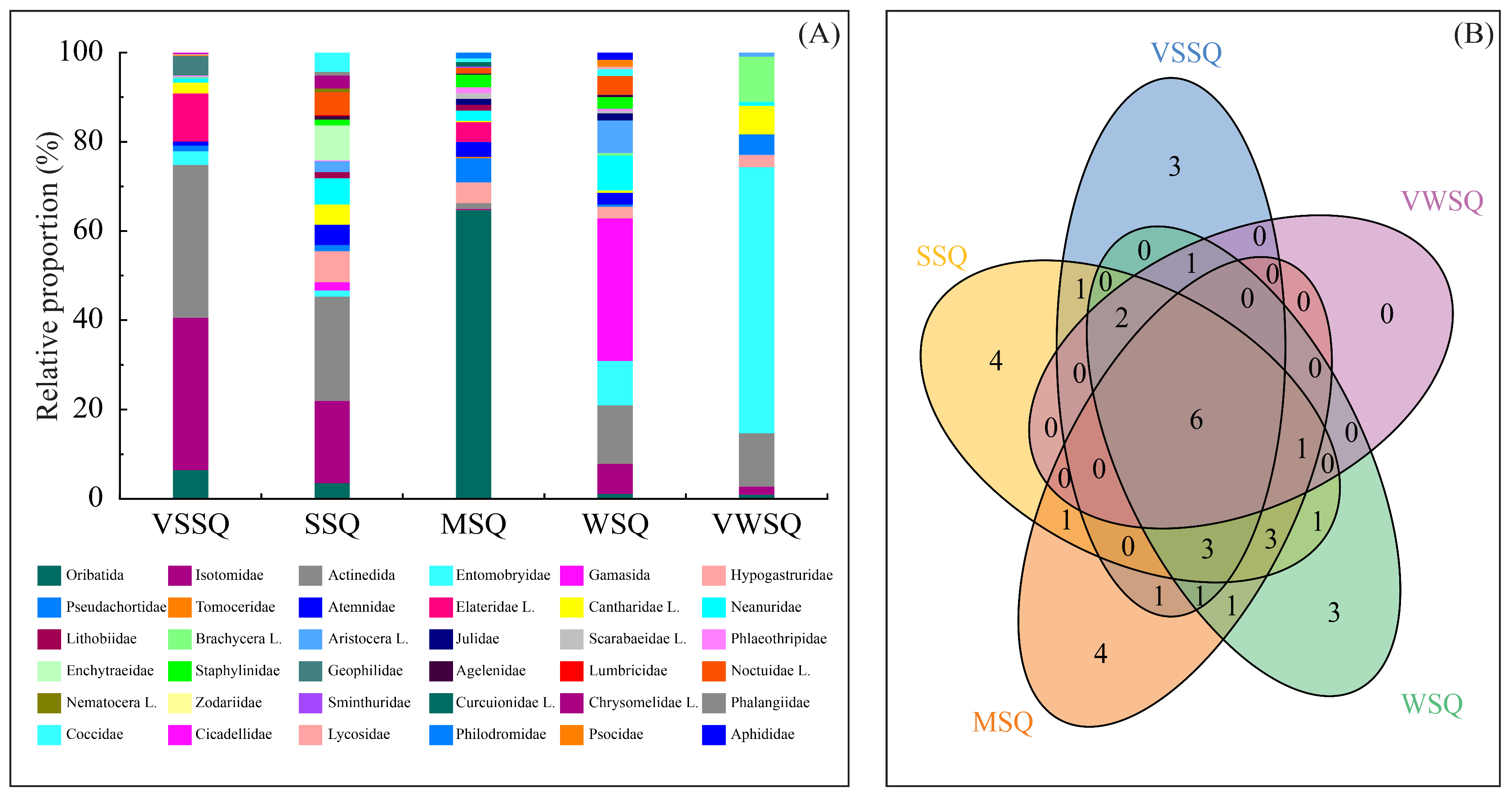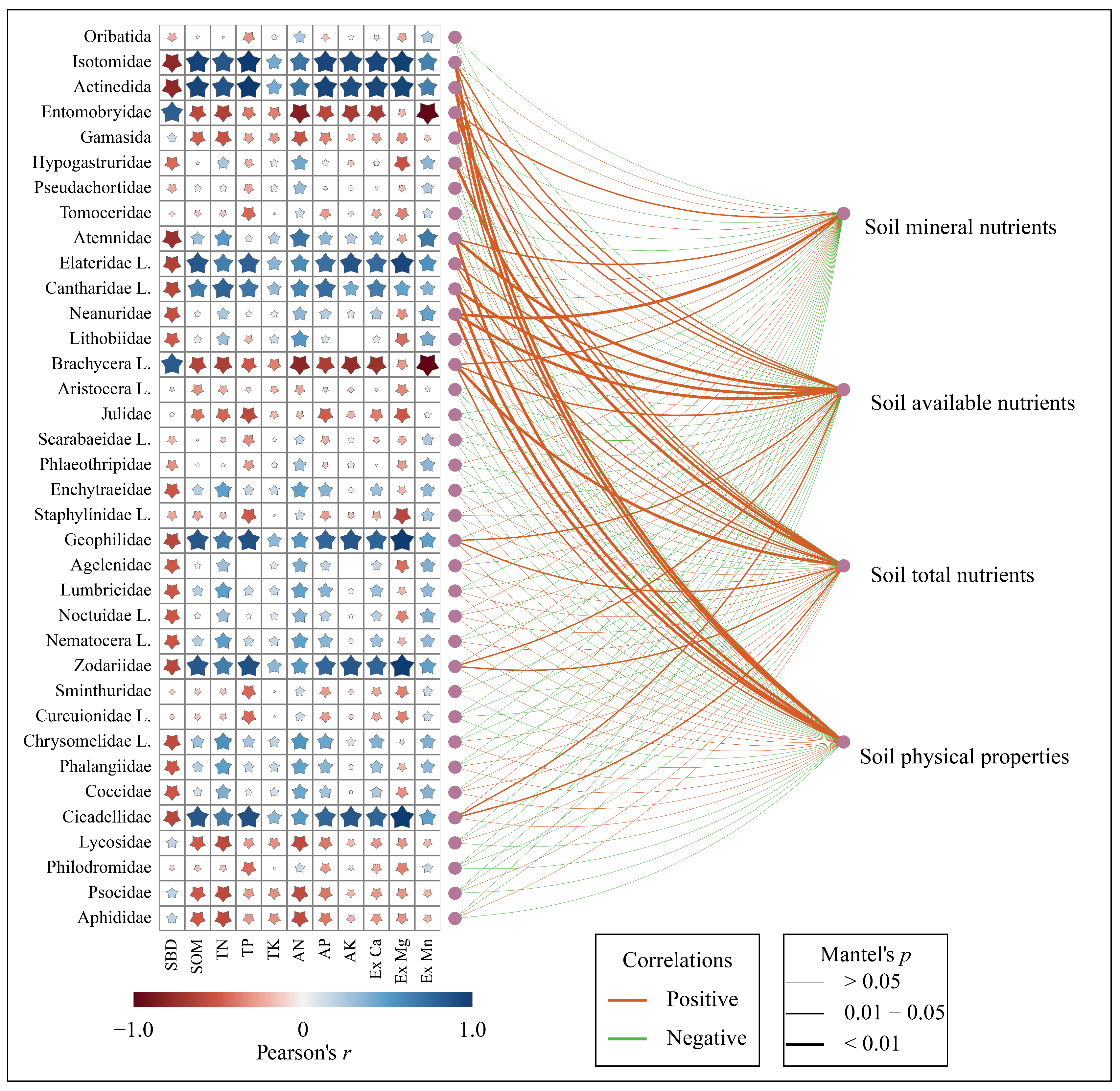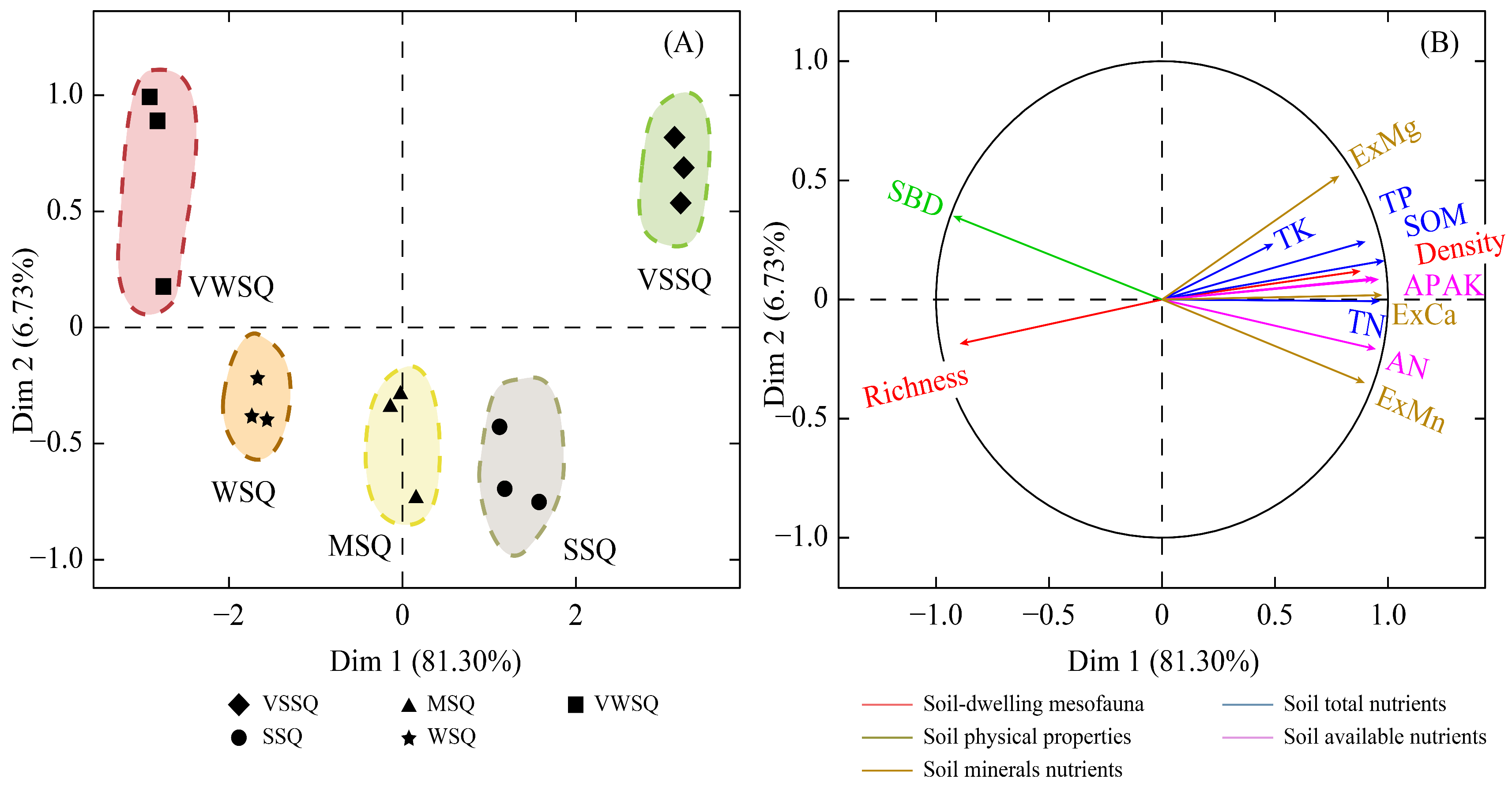Effects of Soil Quality Decline on Soil-Dwelling Mesofaunal Communities in Agricultural Lands of the Mollisols Region, China
Abstract
:1. Introduction
2. Materials and Methods
2.1. Study Area and Sampling Design
2.2. Processing of Samples
2.3. Assessment of Soil Quality
2.4. Statistical Analysis
3. Results
3.1. Soil Quality
3.2. Soil-Dwelling Mesofauna
3.3. Relationship between Soil-Dwelling Mesofauna and Soil Quality
4. Discussion
4.1. Community Characteristics of Soil-Dwelling Mesofauna under Soil Quality Decline
4.2. Exploring the Relationship between Soil-Dwelling Mesofaunal Communities and Soil Quality Decline
5. Conclusions
Supplementary Materials
Author Contributions
Funding
Institutional Review Board Statement
Data Availability Statement
Conflicts of Interest
References
- Lehmann, J.; Bossio, D.A.; Kögel-Knabner, I.; Rillig, M.C. The concept and future prospects of soil health. Nat. Rev. Earth Environ. 2020, 1, 544–553. [Google Scholar] [CrossRef] [PubMed]
- IPCC. IPCC Special Report: Climate Change and Land; IPCC: Geneva, Switzerland, 2019.
- Simonson, R.W. Soil Classification in the United States. Science 1962, 137, 1027–1034. [Google Scholar] [CrossRef] [PubMed]
- Kassam, A.; Friedrich, T.; Derpsch, R. Global spread of conservation agriculture. Int. J. Environ. Stud. 2019, 76, 29–51. [Google Scholar] [CrossRef]
- Kravchenko, Y.S.; Chen, Q.; Liu, X.; Herbert, S.J.; Zhang, X. Conservation practices and management in Ukrainian mollisols. J. Agric. Sci. Technol. 2016, 18, 845–854. [Google Scholar]
- Ouyang, W.; Wu, Y.; Hao, Z.; Zhang, Q.; Bu, Q.; Gao, X. Combined impacts of land use and soil property changes on soil erosion in a mollisol area under long-term agricultural development. Sci. Total Environ. 2018, 613–614, 798–809. [Google Scholar] [CrossRef] [PubMed]
- Wang, S.; Wang, Z.; Heinonsalo, J.; Zhang, Y.; Liu, G. Soil organic carbon stocks and dynamics in a mollisol region: A 1980s–2010s study. Sci. Total Environ. 2022, 807, 150910. [Google Scholar] [CrossRef] [PubMed]
- Adetunji, A.T.; Ncube, B.; Mulidzi, R.; Lewu, F.B. Management impact and benefit of cover crops on soil quality: A review. Soil Till. Res. 2020, 204, 104717. [Google Scholar] [CrossRef]
- Zhan, T.; Zhang, Z.; Sun, J.; Liu, M.; Zhang, X.; Peng, F.; Tsunekawa, A.; Zhou, H.; Gou, X.; Fu, S. Meta-Analysis demonstrating that moderate grazing can improve the soil quality across China’s grassland ecosystems. Appl. Soil Ecol. 2020, 147, 103438. [Google Scholar] [CrossRef]
- Hermans, S.M.; Buckley, H.L.; Case, B.S.; Curran-Cournane, F.; Taylor, M.; Lear, G. Using soil bacterial communities to predict physico-chemical variables and soil quality. Microbiome 2020, 8, 79. [Google Scholar] [CrossRef]
- Leul, Y.; Assen, M.; Damene, S.; Legass, A. Effects of land use types on soil quality dynamics in a tropical sub-humid ecosystem, Western Ethiopia. Ecol. Indic. 2023, 147, 110024. [Google Scholar] [CrossRef]
- Yan, S.; Singh, A.N.; Fu, S.; Liao, C.; Wang, S.; Li, Y.; Cui, Y.; Hu, L. A soil fauna index for assessing soil quality. Soil Biol. Biochem. 2012, 47, 158–165. [Google Scholar] [CrossRef]
- Li, Y.; Wang, J.; Shao, M. Assessment of earthworms as an indicator of soil degradation: A case-study on Loess Soils. Land Degrad. Dev. 2021, 32, 2606–2617. [Google Scholar] [CrossRef]
- Kamau, S.; Barrios, E.; Karanja, N.K.; Ayuke, F.O.; Lehmann, J. Dominant tree species and earthworms affect soil aggregation and carbon content along a soil degradation gradient in an agricultural landscape. Geoderma 2020, 359, 113983. [Google Scholar] [CrossRef]
- De Araújo, A.S.F.; Eisenhauer, N.; Nunes, L.A.P.L.; Leite, L.F.C.; Cesarz, S. Soil surface-active fauna in degraded and restored lands of Northeast Brazil. Land Degrad. Dev. 2013, 26, 1–8. [Google Scholar] [CrossRef]
- Martin, T.; Wade, J.; Singh, P.; Sprunger, C.D. The integration of nematode communities into the soil biological health framework by factor analysis. Ecol. Indic. 2022, 136, 108676. [Google Scholar] [CrossRef]
- Bradford, M.A.; Jones, T.H.; Bardgett, R.D.; Black, H.I.J.; Boag, B.; Bonkowski, M.; Cook, R.; Eggers, T.; Gange, A.C.; Grayston, S.J.; et al. Impacts of soil faunal community composition on model grassland ecosystems. Science 2002, 298, 615–618. [Google Scholar] [CrossRef] [PubMed]
- Ma, C.; Yin, X.; Xu, H.; Tao, Y. Responses of soil Collembolans to vegetation restoration in temperate coniferous and broad-leaved mixed forests. J. For. Res. 2020, 31, 2333–2345. [Google Scholar] [CrossRef]
- Beaumelle, L.; Thouvenot, L.; Hines, J.; Jochum, M.; Eisenhauer, N.; Phillips, H.R.P. Soil fauna diversity and chemical stressors: A review of knowledge gaps and roadmap for future research. Ecography 2021, 44, 845–859. [Google Scholar] [CrossRef]
- Arboláez, H.P.H.; Hu, J.; Orozco, Y.N.; Gebremikael, M.T.; Alcantara, E.A.; Sleutel, S.; Höfte, M.; De Neve, S. Mesofauna as effective indicators of soil quality differences in the agricultural systems of Central Cuba. Appl. Soil Ecol. 2023, 182, 104688. [Google Scholar] [CrossRef]
- Ren, H.; Lv, H.; Xu, Q.; Yao, Z.; Yao, P.; Zhao, N.; Wang, Z.; Huang, D.; Cao, W.; Gao, Y.; et al. Green manure provides growth benefits for soil mesofauna by promoting soil fertility in agroecosystems. Soil Tillage Res. 2024, 238, 106006. [Google Scholar] [CrossRef]
- Ma, C.; Nie, R.; Du, G. Responses of soil collembolans to land degradation in a black soil region in China. Int. J. Environ. Res. Public Health 2023, 20, 4820. [Google Scholar] [CrossRef] [PubMed]
- Urbanowski, C.K.; Turczański, K.; Andrzejewska, A.; Kamczyc, J.; Jagodziński, A.M. Which soil properties affect soil mite (Acari, Mesostigmata) communities in stands with various shares of European ash (Fraxinus Excelsior L.)? Appl. Soil Ecol. 2022, 180, 104633. [Google Scholar] [CrossRef]
- Mantoni, C.; Pellegrini, M.; Dapporto, L.; Del Gallo, M.; Pace, L.; Silveri, D.; Fattorini, S. Comparison of soil biology quality in organically and conventionally managed agro-ecosystems using microarthropods. Agriculture 2021, 11, 1022. [Google Scholar] [CrossRef]
- D’Hose, T.; Cougnon, M.; De Vliegher, A.; Vandecasteele, B.; Viaene, N.; Cornelis, W.; Van Bockstaele, E.; Reheul, D. The positive relationship between soil quality and crop production: A case study on the effect of farm compost application. Appl. Soil Ecol. 2014, 75, 189–198. [Google Scholar] [CrossRef]
- Yin, W.Y. Soil Animals of China; Science Press: Beijing, China, 2000. [Google Scholar]
- Walkley, A.; Black, I.A. An examination of the degtjareff method for determining soil organic matter, and a proposed modification of the chromic acid titration method. Soil Sci. 1934, 37, 29–38. [Google Scholar] [CrossRef]
- Bao, S. Soil Agro-Chemistrical Analysis; China Agricultural Press: Beijing, China, 2000. [Google Scholar]
- Klute, A. Methods of Soil Analysis: Physical and Mineralogical Methods; American Society of Agronomy: Madison, WI, USA, 1986. [Google Scholar]
- Page, A.L. Methods of Soil Analysis: Chemical and Microbiological Properties; American Society of Agronomy: Madison, WI, USA, 1982. [Google Scholar]
- Nakajima, T.; Lal, R.; Jiang, S. Soil quality index of a Crosby silt loam in Central Ohio. Soil Till. Res. 2015, 146, 323–328. [Google Scholar] [CrossRef]
- Brejda, J.J.; Moorman, T.B.; Karlen, D.L.; Dao, T.H. Identification of regional soil quality factors and indicators I. Central and Southern High Plains. Soil Sci. Soc. Am. J. 2000, 64, 2115–2124. [Google Scholar] [CrossRef]
- Zhang, G.; Bai, J.; Xi, M.; Zhao, Q.; Lu, Q.; Jia, J. Soil quality assessment of coastal wetlands in the Yellow River Delta of China Based on the minimum data set. Ecol. Indic. 2016, 66, 458–466. [Google Scholar] [CrossRef]
- Nabiollahi, K.; Golmohamadi, F.; Taghizadeh-Mehrjardi, R.; Kerry, R.; Davari, M. Assessing the effects of slope gradient and land use change on soil quality degradation through digital mapping of soil quality indices and soil loss rate. Geoderma 2018, 318, 16–28. [Google Scholar] [CrossRef]
- Andrews, S.S.; Karlen, D.L.; Cambardella, C.A. The soil management assessment framework. Soil Sci. Soc. Am. J. 2004, 68, 1945–1962. [Google Scholar] [CrossRef]
- Zeraatpisheh, M.; Bakhshandeh, E.; Hosseini, M.; Alavi, S.M. Assessing the effects of deforestation and intensive agriculture on the soil quality through digital soil mapping. Geoderma 2020, 363, 114139. [Google Scholar] [CrossRef]
- Raiesi, F. A minimum data set and soil quality index to quantify the effect of land use conversion on soil quality and degradation in native rangelands of upland arid and semiarid regions. Ecol. Indic. 2017, 75, 307–320. [Google Scholar] [CrossRef]
- Bastida, F.; Luis Moreno, J.; Hernández, T.; García, C. Microbiological degradation index of soils in a semiarid climate. Soil Biol. Biochem. 2006, 38, 3463–3473. [Google Scholar] [CrossRef]
- Sheidai Karkaj, E.; Sepehry, A.; Barani, H.; Motamedi, J.; Shahbazi, F. Establishing a suitable soil quality index for semi-arid rangeland ecosystems in Northwest of Iran. J. Soil Sci. Plant Nut. 2019, 19, 648–658. [Google Scholar] [CrossRef]
- Andrews, S.S.; Karlen, D.L.; Mitchell, J.P. A Comparison of soil quality indexing methods for vegetable production systems in Northern California. Agr. Ecosyst. Environ. 2002, 90, 25–45. [Google Scholar] [CrossRef]
- Qi, Y.; Darilek, J.L.; Huang, B.; Zhao, Y.; Sun, W.; Gu, Z. Evaluating soil quality indices in an agricultural region of Jiangsu Province, China. Geoderma 2009, 149, 325–334. [Google Scholar] [CrossRef]
- R Core Team. R: A Language and Environment for Statistical Computing. Available online: https://www.R-project.org/ (accessed on 31 October 2023).
- Chen, H. VennDiagram: Generate High-Resolution Venn and Euler Plots. R Package Version 1.7.3. Available online: https://CRAN.R-project.org/package=VennDiagram (accessed on 12 April 2022).
- Oksanen, J.; Simpson, G.; Blanchet, F.; Kindt, R.; Legendre, P.; Minchin, P.R.; O’Hara, R.B.; Solymos, P.; Stevens, M.H.H.; Szoecs, E.; et al. Vegan: Community Ecology Package_R Package Version 2.6-4. 2022. Available online: https://CRAN.R-project.org/package=vegan (accessed on 11 October 2022).
- Kolde, R. Pheatmap: Pretty Heatmaps. R Package, Version 1.0.12. Available online: https://CRAN.R-project.org/package=pheatmap (accessed on 4 January 2019).
- Le, S.; Josse, J.; Husson, F. FactoMineR: An R package for multivariate analysis. J. Stat. Softw. 2008, 25, 1–18. [Google Scholar] [CrossRef]
- Peng, J.; Yang, Q.; Zhang, C.; Ni, S.; Wang, J.; Cai, C. Aggregate pore structure, stability characteristics, and biochemical properties induced by different cultivation durations in the Mollisol region of Northeast China. Soil Tillage Res. 2023, 233, 105797. [Google Scholar] [CrossRef]
- Oszust, M.; Klimaszyk, P. Soil conditions under cormorant colonies favor for mites excepting Oribatida. Acarologia 2022, 62, 974–988. [Google Scholar] [CrossRef]
- Xiao, H.; Xu, M.; Wang, Z.; Wang, L.; Wang, J.; Xiao, Y.; Shi, Z. Role of autotrophic microbes in organic matter accumulation in soils degraded by erosion. Land Degrad. Dev. 2022, 33, 2092–2102. [Google Scholar] [CrossRef]
- Bernard, E.C. Soil Arthropods: Underfoot and all around. In Encyclopedia of Soils in the Environment; Goss, M.J., Oliver, M., Eds.; Academic Press: Cambridge, MA, USA, 2023. [Google Scholar]
- Rousseau, L.; Fonte, S.J.; Téllez, O.; van der Hoek, R.; Lavelle, P. Soil macrofauna as indicators of soil quality and land use impacts in smallholder agroecosystems of Western Nicaragua. Ecol. Indic. 2013, 27, 71–82. [Google Scholar] [CrossRef]
- Li, Y.; Ma, L.; Wang, J.; Shao, M.; Zhang, J. Soil faunal community composition alters nitrogen distribution in different land use types in the Loess Plateau, China. Appl. Soil Ecol. 2021, 163, 103910. [Google Scholar] [CrossRef]
- Xu, G.; Zhang, Y.; Zhang, S.; Ma, K. Biodiversity associations of soil fauna and plants depend on plant life form and are accounted for by rare taxa along an elevational gradient. Soil Biol. Biochem. 2020, 140, 107640. [Google Scholar] [CrossRef]
- Wen, Y.; Kasielke, T.; Li, H.; Zhang, B.; Zepp, H. May agricultural terraces induce gully erosion? A case study from the Black Soil Region of Northeast China. Sci. Total Environ. 2021, 750, 141715. [Google Scholar] [CrossRef]
- Li, H.; Zhu, H.; Qiu, L.; Wei, X.; Liu, B.; Shao, M. Response of soil OC, N and P to land-use change and erosion in the black soil region of the Northeast China. Agric. Ecosyst. Environ. 2020, 302, 107081. [Google Scholar] [CrossRef]
- Jensen, J.L.; Schjønning, P.; Watts, C.W.; Christensen, B.T.; Obour, P.B.; Munkholm, L.J. Soil degradation and recovery–Changes in organic matter fractions and structural stability. Geoderma 2020, 364, 114181. [Google Scholar] [CrossRef]
- Guidi, C.; Frey, B.; Brunner, I.; Meusburger, K.; Vogel, M.E.; Chen, X.; Stucky, T.; Gwiazdowicz, D.J.; Skubała, P.; Bose, A.K.; et al. Soil fauna drives vertical redistribution of soil organic carbon in a long-term irrigated dry pine forest. Glob. Change Biol. 2022, 28, 3145–3160. [Google Scholar] [CrossRef] [PubMed]
- Wiens, J.J.; Ackerly, D.D.; Allen, A.P.; Anacker, B.L.; Buckley, L.B.; Cornell, H.V.; Damschen, E.I.; Jonathan Davies, T.; Grytnes, J.; Harrison, S.P.; et al. Niche Conservatism as an Emerging Principle in Ecology and Conservation Biology. Ecol. Lett. 2010, 13, 1310–1324. [Google Scholar] [CrossRef]
- Hardin, G. The competitive exclusion principle: An idea that took a century to be born has implications in ecology, economics, and genetics. Science 1960, 131, 1292–1297. [Google Scholar] [CrossRef]
- Wardle, D.A.; Bardgett, R.D.; Klironomos, J.N.; Setälä, H.; van der Putten, W.H.; Wall, D.H. Ecological linkages between aboveground and belowground biota. Science 2004, 304, 1629–1633. [Google Scholar] [CrossRef]
- Rusek, J. Biodiversity of Collembola and their functional role in the ecosystem. Biodivers. Conserv. 1998, 7, 1207–1219. [Google Scholar] [CrossRef]
- Betancur-Corredor, B.; Lang, B.; Russell, D.J. Organic nitrogen fertilization benefits selected soil fauna in global agroecosystems. Biol. Fertil. Soils 2023, 59, 1–16. [Google Scholar] [CrossRef]
- Hedde, M.; Blight, O.; Briones, M.J.; Bonfanti, J.; Brauman, A.; Brondani, M.; Sanou, I.C.; Clause, J.; Conti, E.; Cortet, J.; et al. A common framework for developing robust soil fauna classifications. Geoderma 2022, 426, 116073. [Google Scholar] [CrossRef]
- Maraun, M.; Martens, H.; Migge, S.; Theenhaus, A.; Scheu, S. Adding to ‘the enigma of soil animal diversity’: Fungal feeders and saprophagous soil invertebrates prefer similar food substrates. Eur. J. Soil Biol. 2003, 39, 85–95. [Google Scholar] [CrossRef]
- Woodcock, B.A.; Potts, S.G.; Westbury, D.B.; Ramsay, A.J.; Lambert, M.; Harris, S.J.; Brown, V.K. The importance of sward architectural complexity in structuring predatory and phytophagous invertebrate assemblages. Ecol. Entomol. 2007, 32, 302–311. [Google Scholar] [CrossRef]
- Lindo, Z.; Winchester, N.N. Spatial and Environmental Factors Contributing to Patterns in Arboreal and Terrestrial Oribatid Mite Diversity across Spatial Scales. Oecologia 2009, 160, 817–825. [Google Scholar] [CrossRef] [PubMed]
- Kardol, P.; Reynolds, W.N.; Norby, R.J.; Classen, A.T. Climate Change Effects on Soil Microarthropod Abundance and Community Structure. Appl. Soil Ecol. 2011, 47, 37–44. [Google Scholar] [CrossRef]
- Malheiro, C.; Cardoso, D.N.; Loureiro, S.; González-Alcaraz, M.N. Effects of climate conditions on the avoidance behavior of Folsomia candida and Enchytraeus crypticus towards metal (loid)-contaminated soils. Sci. Total Environ. 2020, 741, 140368. [Google Scholar] [CrossRef]
- Kou, X.; Tao, Y.; Wang, S.; Wu, Z.; Wu, H. Soil meso-fauna community composition predicts ecosystem multifunctionality along a coastal-inland gradient of the Bohai Bay. Land Degrad. Dev. 2021, 32, 4574–4582. [Google Scholar] [CrossRef]
- Zhang, Y.; Peng, S.; Chen, X.; Chen, H.Y. Plant diversity increases the abundance and diversity of soil fauna: A meta-analysis. Geoderma 2022, 411, 115694. [Google Scholar] [CrossRef]







| Sampling Fields | Yield Levels | Average Annual Yields (kg/hm2) |
|---|---|---|
| SF I | Very high yields | 12,000 |
| SF II | High yields | 10,000 |
| SF III | Moderate yields | 8000 |
| SF IV | Low yields | 6000 |
| SF V | Very low yields | 4000 |
| Soil Properties | Sampling Fields | ||||
|---|---|---|---|---|---|
| SF I | SF II | SF III | SF IV | SF V | |
| Soil bulk density (g/cm3) | 1.20 ± 0.01 c | 1.21 ± 0.02 c | 1.26 ± 0.01 b | 1.29 ± 0.01 b | 1.37 ± 0.02 a |
| Soil organic matter (g/kg) | 18.45 ± 0.01 a | 13.60 ± 0.14 b | 10.92 ± 0.08 c | 8.29 ± 0.04 d | 7.24 ± 0.07 e |
| TN (g/kg) | 2.23 ± 0.01 a | 2.11 ± 0.03 b | 1.65 ± 0.01 c | 1.35 ± 0.01 d | 1.3 ± 0.01 d |
| TP (g/kg) | 0.63 ± 0.01 a | 0.54 ± 0.01 b | 0.46 ± 0.01 cd | 0.47 ± 0.01 c | 0.44 ± 0.01 d |
| TK (g/kg) | 14.54 ± 0.27 a | 14.40 ± 0.27 a | 14.26 ± 0.01 a | 14.04 ± 0.08 a | 14.00 ± 0.38 a |
| AN (mg/kg) | 225.37 ± 1.12 a | 223.84 ± 2.15 a | 210.36 ± 1.44 b | 181.90 ± 1.12 c | 173.75 ± 1.09 d |
| AP (mg/kg) | 17.03 ± 0.24 a | 15.38 ± 0.32 b | 12.69 ± 0.08 c | 12.24 ± 0.04 c | 11.1 ± 0.26 d |
| AK (mg/kg) | 181.73 ± 2.35 a | 143.97 ± 1.78 b | 137.26 ± 1.47 c | 133.79 ± 2.04 c | 106.28 ± 1.94 d |
| ExCa (g/kg) | 2.52 ± 0.03 a | 2.08 ± 0.04 b | 1.59 ± 0.01 c | 1.53 ± 0.01 c | 1.12 ± 0.01 d |
| ExMg (g/kg) | 0.82 ± 0.01 a | 0.59 ± 0.02 b | 0.56 ± 0.01 b | 0.57 ± 0.01 b | 0.56 ± 0.01 b |
| ExMn (mg/kg) | 63.29 ± 2.00 a | 60.9 ± 1.03 ab | 57.74 ± 0.36 b | 51.77 ± 0.36 c | 38.20 ± 0.25 d |
Disclaimer/Publisher’s Note: The statements, opinions and data contained in all publications are solely those of the individual author(s) and contributor(s) and not of MDPI and/or the editor(s). MDPI and/or the editor(s) disclaim responsibility for any injury to people or property resulting from any ideas, methods, instructions or products referred to in the content. |
© 2024 by the authors. Licensee MDPI, Basel, Switzerland. This article is an open access article distributed under the terms and conditions of the Creative Commons Attribution (CC BY) license (https://creativecommons.org/licenses/by/4.0/).
Share and Cite
Ma, C.; Yao, X.; Du, G. Effects of Soil Quality Decline on Soil-Dwelling Mesofaunal Communities in Agricultural Lands of the Mollisols Region, China. Agriculture 2024, 14, 766. https://doi.org/10.3390/agriculture14050766
Ma C, Yao X, Du G. Effects of Soil Quality Decline on Soil-Dwelling Mesofaunal Communities in Agricultural Lands of the Mollisols Region, China. Agriculture. 2024; 14(5):766. https://doi.org/10.3390/agriculture14050766
Chicago/Turabian StyleMa, Chen, Xin Yao, and Guoming Du. 2024. "Effects of Soil Quality Decline on Soil-Dwelling Mesofaunal Communities in Agricultural Lands of the Mollisols Region, China" Agriculture 14, no. 5: 766. https://doi.org/10.3390/agriculture14050766
APA StyleMa, C., Yao, X., & Du, G. (2024). Effects of Soil Quality Decline on Soil-Dwelling Mesofaunal Communities in Agricultural Lands of the Mollisols Region, China. Agriculture, 14(5), 766. https://doi.org/10.3390/agriculture14050766






